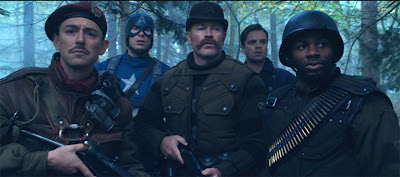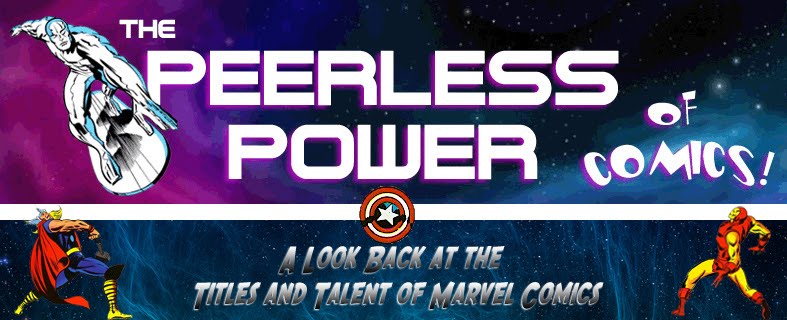It seems only appropriate today to put the spotlight on a particular 2011 movie, one which I've been watching a lot of lately--and it's a film that proved to me that a film based on a Marvel comics character can be a well-made one. Such attempts have been somewhat hit-and-miss, though I suppose you could say that about the film industry in general. Most of us can probably only count on the fingers of one hand--maybe two, though that's a stretch--the number of films we've seen where the plot and characters have combined so well as to make a truly excellent piece of work, a film that reflects the efforts of a production crew and cast of actors who gave 150% of themselves to make sure the finished product was everything it could be. I can only imagine how gratifying it would be to work on a creative project like that. But as one of the doubtless many people who were blown away by Captain America: The First Avenger, I can definitely tell you how gratifying it was to watch the final product.
We knew at the time that the character of Captain America was being primed, along with Iron Man, Thor, and the Hulk, to take his place in a franchise of Marvel film product that would hopefully build a perpetual audience base for such films, where a stronger foundation of these "Avengers" would perhaps give a leg up to other such efforts that might come down the pipe. Not all of them would bat a thousand, as we saw when previous films like Fantastic Four flamed out or when Spider-Man as well as the Hulk had to be rebooted. That doesn't necessarily mean the concepts were unworkable--just that the right blend of story and characters needed to be better aligned with the "action" element which such films feel almost duty-bound to present.
 With Captain America, such a blend is more easily accomplished, since we get to know the character of Steve Rogers from the ground up, and his aspirations are more sympathetic to us than those of, for instance, a kid bitten by a radioactive spider. And even when he becomes "Captain America," he comes across as the type of person Dr. Erskine hoped he would remain--"a good man." He remains true to himself, which, in his mind, is a soldier as opposed to a "bully." The scene with Erskine (played so well by Stanley Tucci) and Steve Rogers (Chris Evans), taking place the night before Rogers is scheduled to undergo the super soldier procedure, is perhaps the most profound in the film, because it lays the foundation for who Captain America will be from this point on, whether it's on a World War II battlefield or as a 21st century Avenger. It remains to be seen how Steve Rogers will carry that moral center with him through his dealings with men like Nick Fury--but in this film, in more familiar company and in more familiar surroundings, Captain America flourishes, and grows into his own.
With Captain America, such a blend is more easily accomplished, since we get to know the character of Steve Rogers from the ground up, and his aspirations are more sympathetic to us than those of, for instance, a kid bitten by a radioactive spider. And even when he becomes "Captain America," he comes across as the type of person Dr. Erskine hoped he would remain--"a good man." He remains true to himself, which, in his mind, is a soldier as opposed to a "bully." The scene with Erskine (played so well by Stanley Tucci) and Steve Rogers (Chris Evans), taking place the night before Rogers is scheduled to undergo the super soldier procedure, is perhaps the most profound in the film, because it lays the foundation for who Captain America will be from this point on, whether it's on a World War II battlefield or as a 21st century Avenger. It remains to be seen how Steve Rogers will carry that moral center with him through his dealings with men like Nick Fury--but in this film, in more familiar company and in more familiar surroundings, Captain America flourishes, and grows into his own.Yet aside from the unique aspect of the title character himself, one reason I think Captain America succeeds so well is because of how well it plays on the notion that no man is an island. Steve Rogers may now be a "super soldier," but his character is shaped not only by Erskine but by a number of other people in his new life as a soldier. He has a doubter in the form of his commanding officer, Colonel Phillips (the well-cast Tommy Lee Jones), but also an equally staunch proponent in Agent Carter (Hayley Atwell) who sees in Rogers the same qualities that Erskine saw and who serves to remind him after Erskine's death of his greater role in the war. Carter, like Phillips, pulls no punches--and with opposing points of view, they help Rogers come to terms with who he is and what he must do. Even if Evans for some reason hadn't been able to bring both Steve Rogers and Captain America to life as well as he did, Jones and Atwell chew the scenery so well that their scenes would have gone far to take up any perceived slack.
 Once Captain America takes a more active role in the war, the focus shifts to his interaction with his comrades in arms--such an excellent choice of a direction to go in, as opposed to sending Cap off on solo missions where he displays his super soldier mettle in fight scene after fight scene. World War II was a team effort, with many specialized groupings of soldiers pulling their weight and forming bonds that would take them through hell--and writers Christopher Markus and Stephen McFeely pick the perfect group from Marvel lore for Cap to team up with, the Howling Commandos. As well as the Commandos establish a chemistry with themselves, it's the chemistry of joining Cap in the film during the montage of scenes they're in together which helps Captain America to cement its standing with the audience, noticeably picking up the pace and giving us the exciting imagery of Cap in battlefield conditions. One of the rules of good theatre is to "always leave them wanting more"--and I certainly wouldn't have complained about having a few more scenes of Cap fighting alongside the Commandos on a few more raiding missions. That said, what we did have was a perfect fit for the film as a whole.
Once Captain America takes a more active role in the war, the focus shifts to his interaction with his comrades in arms--such an excellent choice of a direction to go in, as opposed to sending Cap off on solo missions where he displays his super soldier mettle in fight scene after fight scene. World War II was a team effort, with many specialized groupings of soldiers pulling their weight and forming bonds that would take them through hell--and writers Christopher Markus and Stephen McFeely pick the perfect group from Marvel lore for Cap to team up with, the Howling Commandos. As well as the Commandos establish a chemistry with themselves, it's the chemistry of joining Cap in the film during the montage of scenes they're in together which helps Captain America to cement its standing with the audience, noticeably picking up the pace and giving us the exciting imagery of Cap in battlefield conditions. One of the rules of good theatre is to "always leave them wanting more"--and I certainly wouldn't have complained about having a few more scenes of Cap fighting alongside the Commandos on a few more raiding missions. That said, what we did have was a perfect fit for the film as a whole.Nor can you speak of good chemistry without mentioning Rogers' interplay with his best friend, Bucky Barnes (played by Sebastian Stan)--who went from looking out for the skinny, outmatched Rogers to looking up to him as an inspiration on the battlefield. When "Captain America" makes his appearance, the shift in Bucky's relationship with Rogers and the further development of their friendship as a result is integral to how Cap molds his character as well as his presence on the battlefield. In a way, Bucky is still very much looking out for Rogers, though now supportively at his side. Stan plays the role of soldier far more seriously in demeanor on the battlefield than the brawling, bar-hunting Commandos; that may or may not be because of groundwork being laid for his character in the upcoming Winter Soldier installment, but you can't help but note the contrast. While he's unquestionably at Rogers' side, both literally and in spirit, there are times when he's noticeably (and grimly) doing his duty at a distance on the field. Even in the bar scene with the Commandos, he's drinking in another room, separate from them. Yet it doesn't detract from either his friendship with Rogers, or (again) their chemistry in this film.
That leaves the visual and technical aspects of the film itself, which combine with the cast as well as the direction of Joe Johnston to essentially create a superb period piece cum action flick. Johnston and his production team show a marvelous grasp of the 1940s throughout--in the city scene where Rogers races to capture a Hydra assassin, in the hairstyles and costumes, or in the sets featuring electronics consoles with those wonderful gauges and needle indicators and knobs. It was especially impressive at how well the film blended futuristic elements into the time period without pushing past the limits of our credulity--no easy task when scenes call for disintegrator rays, even with the excuse of an artifact like the Tesseract.
And what about those nice touches? How about that nod to the original Arnim Zola design, with Toby Jones' face appearing in that magnifier? And others, like the camera cutting to Hodge, the "Cap that might have been," as Rogers returns from his rescue mission and we realize the right choice was made. The nice contrast of Howard Stark, and his own love of inventing. The very cool look of the Red Skull, brought to life by actor Hugo Weaving. The adaptation of Cap's costume for wartime, infinitely preferable to the updated 21st century "tights" look which takes Evans' new build and turns him back into a skinny recruit. The cry of "Wah-hoo!" from Dugan. The inspirational score by Alan Silvestri. And of course, Cap's shield, which they nailed in every way.
Everything in this film worked so well for me (well, except for those fondue cracks, which just fell flat) that I was almost disppointed when all of it was ripped away at the end in order to bring Cap into present-day New York. Captain America is the kind of film that deserves to end on its own merits, as opposed to a link in a chain. Perhaps a little symmetry might have helped to smooth the transition--say, the film begins with having Rogers recount his 1940s beginnings and subsequent career while he's looking over Phil Coulson's trading cards with him; and as a result, instead of a confused fade-out in Times Square, the credits could have rolled with his new life more in focus for us. But the film still serves to give us a Captain America story--and adventure--that's one for the history books.






No comments:
Post a Comment